Canadian economic accounts, first quarter 2012 and March 2012
Archived Content
Information identified as archived is provided for reference, research or recordkeeping purposes. It is not subject to the Government of Canada Web Standards and has not been altered or updated since it was archived. Please "contact us" to request a format other than those available.
Related subjects
-
[an error occurred while processing this directive]
Real gross domestic product (GDP) rose 0.5% in the first quarter, the same pace as in the previous quarter. Business investment contributed the most to first-quarter GDP growth. Final domestic demand grew 0.3%. On a monthly basis, real GDP by industry edged up 0.1% in March.
As was the case throughout 2011, business investment continued to fuel growth. Business investment in plant and equipment advanced 1.2%, the ninth consecutive quarterly increase. Housing investment expanded 2.9%, well above the previous quarter's pace of 0.8%. Non-farm business inventories increased in the first quarter.
Consumer spending on goods and services, another main contributor to GDP growth in 2011, slowed to 0.2% in the first quarter of 2012, after a 0.7% gain in the previous quarter.
In the first quarter, final domestic demand advanced 0.3%. Growth in final domestic demand has been slowing since the first quarter of 2011. Average quarterly growth in final domestic demand was 0.5% in 2011, following 1.1% in 2010.
While exports have been increasing since the second quarter of 2011, they remain below the level reached in the third quarter of 2008. Exports grew 0.6% in the first quarter of 2012, after gaining 1.7% in the previous quarter.
Imports rose 1.1% in the first quarter, almost double the pace of the fourth quarter of 2011.
Growth of real gross domestic product and final domestic demand
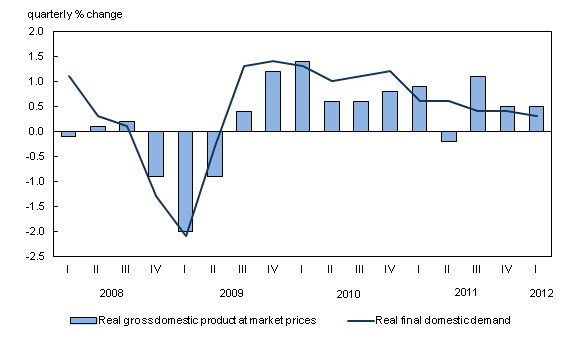
Chart description: Growth of real gross domestic product and final domestic demand
The output of service industries grew 0.5%, while goods production was unchanged. Wholesale trade and construction were the main contributors to overall growth. Manufacturing, the finance and insurance sector, professional services, and health care services also grew, while mining and utilities recorded notable decreases.
Wholesale trade advanced 2.0% on the strength of motor vehicles and parts. Construction increased 1.2%, with gains in residential building construction and in engineering and repair work. Oil and gas extraction edged up 0.1% in the first quarter, as increased crude petroleum production was mostly offset by a decrease in natural gas extraction. Support activities for mining and oil and gas extraction fell 8.2%, as a result of declines in drilling and rigging services. Mining excluding oil and gas extraction decreased, mainly as a result of lower output at potash and at copper, nickel, lead and zinc mines. Utilities declined 1.4%, as unseasonably warm weather contributed to lower demand for electricity and natural gas.
Expressed at an annualized rate, real GDP expanded 1.9% in the first quarter, matching the rate of the previous quarter. By comparison, real GDP in the United States also grew 1.9% in the first quarter.
Contributions to percent change in real gross domestic product, first quarter 2012
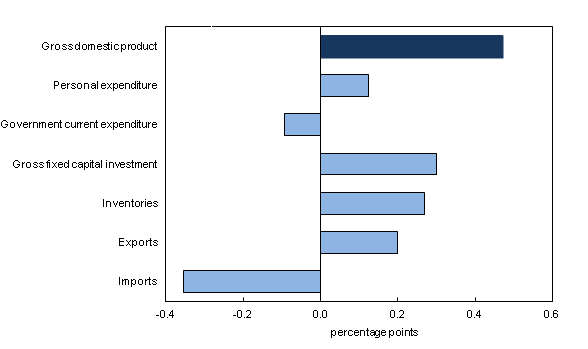
Business investment in plant and equipment continues to expand
Overall business investment in plant and equipment rose 1.2% in the first quarter. Investment in engineering projects advanced 1.5% and investment in buildings expanded 1.1%. Furthermore, business investment in machinery and equipment grew 1.0%, following two consecutive quarters of decline. This increase was led by business purchases of automobiles (+8.9%), agricultural machinery (+7.0%), and other machinery and equipment (+4.3%). In contrast, there were declines in investment in computers and other office equipment (-7.0%) and in other transportation equipment (-3.1%).
Business investment in non-residential structures and equipment
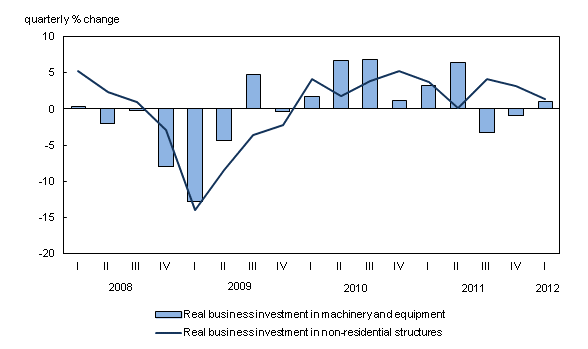
Chart description: Business investment in non-residential structures and equipment
Housing demand strengthens
Housing investment grew 2.9% in the first quarter, the fifth consecutive gain. New housing construction increased 3.7% after declining in the previous quarter. Renovation activity (+1.7%) was also up, as were ownership transfer costs related to housing resale activity (+3.6%).
Business inventories continue to increase
Businesses increased inventories by $9.4 billion in the first quarter, $4 billion more than in the previous quarter. Wholesale and retail trade inventories accounted for two-thirds of the gain.
Imports increase once again
Imports rose 1.1% in the first quarter, after increasing 0.6% in the previous quarter. Most major categories of imported goods increased, especially automotive products (+9.2%). Imports of services grew 2.1%, after a 1.3% increase in the previous quarter.
Demand for exports softens
Exports of goods and services grew 0.6% in the first quarter, although the pace of growth slowed from the preceding two quarters. Exports of goods advanced 0.8%, with energy products (+5.9%) contributing the most to the increase. A 4.0% decline in transportation services contributed to the 0.3% decrease in exports of services.
Consumer spending slows
Consumer spending on goods and services edged up 0.2% in the first quarter, slowing from the previous quarter's pace of 0.7%. Purchases of semi-durable goods (+1.1%) and services (+0.7%) both increased. These increases were partially offset by reductions in purchases of durable (-0.1%) and non-durable goods (-1.0%).
Purchases of clothing, footwear and accessories increased 2.3%, the seventh consecutive quarterly increase.
Spending on furniture, carpets and other floor coverings advanced 2.4%, following two successive quarterly declines.
In contrast, spending on transportation and communication decreased 0.3% in the first quarter. A 1.2% increase in purchased transportation was offset by declines in outlays on fuel and lubricants (-2.1%) as well as on motor vehicle repairs and parts (-0.4%).
Economy-wide income expands
Nominal GDP increased 0.6% in the first quarter. Corporate profits fell 2.6% following 4% or more growth in the two previous quarters. Declines in earnings of non-financial corporations were partially offset by increased earnings of financial institutions in the first quarter.
Labour income rose 0.7%, slower than the previous quarter's pace of 1.1%. Growth of wages in goods-producing industries slowed to 0.9% from 2.3% in the previous quarter.
The personal saving rate moved down to 2.9% in the first quarter, and has been on a downward trend since the second quarter of 2010, when it was 6.8%. This was the first time the personal saving rate has been below 3% since 2007.
However, the national saving rate was 7.3%, higher than the 6.5% average quarterly growth recorded throughout 2011. Government revenues were up 2.0% in the quarter, outpacing government outlays, which rose 0.4%. Corporate saving was also up, as corporate outlays were reduced.
Canada's real gross domestic income, a measure of purchasing power, increased 0.3% in the first quarter. Canada's terms of trade, which measure export prices relative to import prices, declined 0.6%.
The price of goods and services produced in Canada edged up 0.2%. Both export prices (-1.6%) and import prices (-1.0%) fell.
The price of final domestic demand increased 0.3%, compared with a 0.8% increase in the fourth quarter of 2011.
Financial flow accounts: Demand for funds up
Total funds raised by domestic non-financial sectors increased to $179 billion (seasonally adjusted at annual rates) in the first quarter, up from $122 billion in the previous quarter. Increased financing in the non-financial private corporations' sector and higher borrowing in other levels of government led the demand for funds.
The financing activity of non-financial private corporations expanded in the first quarter, reversing the previous quarter's decline. Equity and short-term paper issues were the main instruments of finance in the quarter.
Borrowing by other levels of government increased in the quarter, led by provincial government bond issues. Retirements of federal government short-term paper moderated the increase in overall government borrowing.
Household borrowing (in the form of mortgages, consumer credit and loans) was lower in the quarter, marking three straight quarters of decline. Consumer credit and mortgage borrowing fell 3.2% in the first quarter.
Financial institutions increased their bond and short-term paper holdings, while decreasing their holdings of foreign investments.
Gross domestic product by industry, March 2012
Real gross domestic product edged up 0.1% in March after declining 0.2% in February. The output of service industries grew 0.2%, while goods production declined 0.1%. There were increases in manufacturing, construction, wholesale and retail trade, and accommodation and food services. Declines were recorded in oil and gas extraction, the public sector (education, health, and public administration combined), utilities, and the finance and insurance sector.
Real gross domestic product edges up in March
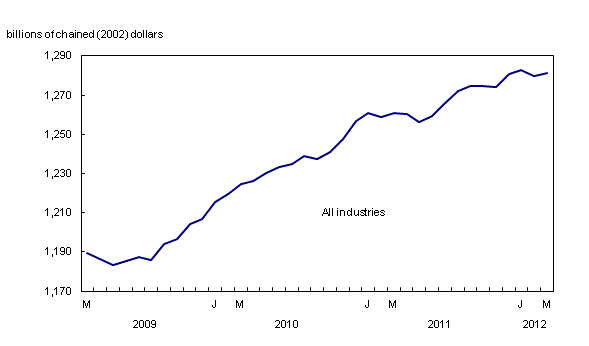
Chart description: Real gross domestic product edges up in March
Manufacturing output increased 0.9% in March after a 0.8% decline in February. The production of durable goods was up 1.0%, notably in the manufacturing of transportation equipment, fabricated metal products and machinery. Non-durable goods production (+0.8%) also rose.
Oil and gas extraction declined 2.4%, with decreases in both crude petroleum and natural gas. Crude petroleum output was particularly affected by maintenance and production difficulties. Mining excluding oil and gas extraction rose 1.8% in March, as output at potash and nickel mines increased following temporary closures in February. This increase outweighed decreases at coal mines in March.
The public sector decreased 0.2% in March as a result of a decline in education services and, to a lesser extent, public administration. Walkouts by some CEGEP and university students in Quebec led to a reduction in the volume of output of education services. Health services edged up.
Wholesale trade (+0.7%) increased for a fourth consecutive month, on the strength of wholesaling of motor vehicles and parts, and petroleum products. Retail trade increased 0.6%, mainly as a result of increases at clothing and clothing accessories stores and at general merchandise stores (including department stores).
Construction rose 0.8%, with all major components (residential and non-residential buildings, engineering and repair work) increasing. The output of real estate agents and brokers grew 1.8% on increased activity in the resale home market.
Utilities decreased 0.9% as the demand for both electricity and natural gas continued to decline partly because of unusually warm weather.
The finance and insurance sector decreased 0.1%, as declines in banks and other credit intermediaries outweighed gains at insurance carriers and security brokerages.
Main industrial sectors' contribution to the percent change in gross domestic product, March 2012
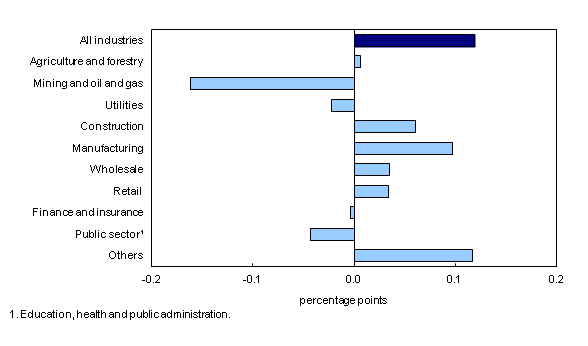
Note to readers
The historical revision to the Canadian National Accounts is scheduled for release beginning in October 2012. A schedule of releases has been posted on the National economic accounts website. Additional information will be posted as it becomes available.
For more information, contact the information officer (csna-info-scnc@statcan.gc.ca).
Percentage changes for expenditure-based and industry-based statistics (such as personal expenditures, investment, exports, imports and output) are calculated from volume measures that are adjusted for price variations. Percentage changes for income-based and flow-of-funds statistics (such as labour income, corporate profits, mortgage borrowing and total funds raised) are calculated from nominal values; that is, they are not adjusted for price variations.
There are four ways of expressing growth rates for gross domestic product (GDP) and other time series found in this release.
1. Unless otherwise stated, the growth rates of all quarterly data in this article represent the percentage change in the series from one quarter to the next, such as from the fourth quarter of 2011 to the first quarter of 2012.
2. Quarterly growth can be expressed at an annual rate by using a compound growth formula, similar to the way in which a monthly interest rate can be expressed at an annual rate. Expressing growth at an annual rate facilitates comparisons with official GDP statistics from the United States. Both the quarterly growth rate and the annualized quarterly growth rate should be interpreted as an indication of the latest trend in GDP.
3. The year-over-year growth rate is the percentage change in GDP from a given quarter in one year to the same quarter one year later, such as from the first quarter of 2011 to the first quarter of 2012.
4. The growth rates of all monthly data in this article represent the percentage change in the series from one month to the next, such as from February to March 2012.
Products, services and contact information
Detailed analysis and tables
The National economic accounts module, accessible from the Key resource module of our website, features an up-to-date portrait of national and provincial economies and their structure.
Additional tables and links to other releases from the national accounts can be found in the first quarter 2012 issue of Canadian Economic Accounts Quarterly Review, Vol. 11, no. 1 (Catalogue number13-010-X, free). This publication is now available from the Key resource module of our website under Publications. This publication will be updated on June 15, at the time of the release of the National Balance Sheet Accounts. Revised estimates of the Income and Expenditure Accounts for the first, second, third and fourth quarters of 2011 have been released, along with those for the first quarter of 2012. These estimates incorporate new and revised source data and updated estimates of seasonal patterns. Because of the 2012 historical revision, the publication of the first quarter 2012 data will include revisions extending back only one year.
Gross domestic product by industry
Available without charge in CANSIM: table CANSIM table379-0027.
Definitions, data sources and methods: survey numbers survey number1301.
The March 2012 issue of Gross Domestic Product by Industry, Vol. 26, no. 3 (Catalogue number15-001-X, free) is now available from the Key resource module of our website under Publications.
Data on gross domestic product by industry for April will be released on June 29.
For more information, or to order data, contact Statistics Canada's National Contact Centre (toll-free 1-800-263-1136; 613-951-8116; infostats@statcan.gc.ca).
To enquire about the concepts, methods or data quality of this release, contact Allan Tomas (613-951-9277), Industry Accounts Division.
Income and expenditure accounts
Available without charge in CANSIM: tables CANSIM table026-0009, CANSIM table380-0001 to 380-0017, CANSIM table380-0019 to 380-0035, CANSIM table380-0056, CANSIM table380-0059 to 380-0062 and CANSIM table382-0006.
Definitions, data sources and methods: survey numbers survey number1901 and survey number2602.
The first quarter 2012 issues of National Income and Expenditure Accounts: Data Tables, Vol. 5, no. 1 (Catalogue number13-019-X, free) and Estimates of Labour Income: Data Tables, Vol. 5, no. 1 (Catalogue number13-021-X, free) are also now available from the Key resource module of our website under Publications.
For more information, or to enquire about the concepts, methods or data quality of this release, consult the Guide to the Income and Expenditure Accounts (Catalogue number13-017-X, free) or contact the information officer (613-951-3640; iead-info-dcrd@statcan.gc.ca), Income and Expenditure Accounts Division.
Financial flow accounts
Available without charge in CANSIM: tables CANSIM table378-0015 to 378-0048.
Definitions, data sources and methods: survey numbers survey number1804.
The first quarter 2012 issue of Financial Flow Accounts: Data Tables, Vol. 5, no. 1 (Catalogue number13-020-X, free), is also now available from the Key resource module of our website under Publications.
For more information, or to order data, contact Statistics Canada's National Contact Centre (toll-free 1-800-263-1136; 613-951-8116; infostats@statcan.gc.ca).
To enquire about the concepts, methods or data quality of this release, contact the information officer (613-951-3640; iead-info-dcrd@statcan.gc.ca), Income and Expenditure Accounts Division.
- Date modified:
